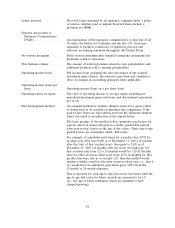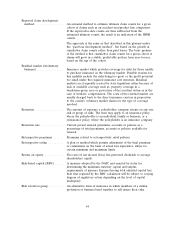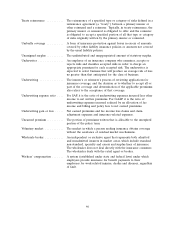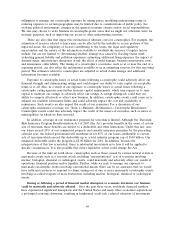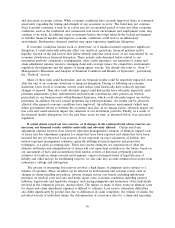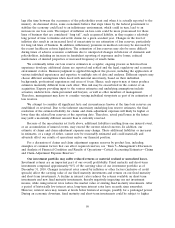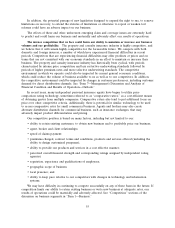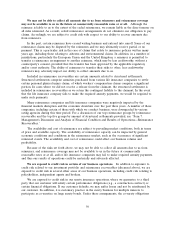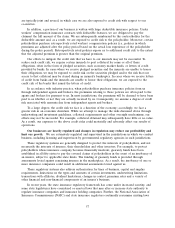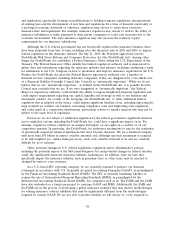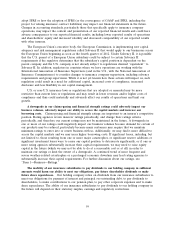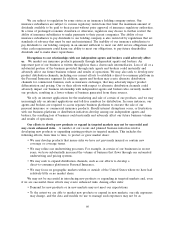Travelers 2010 Annual Report Download - page 64
Download and view the complete annual report
Please find page 64 of the 2010 Travelers annual report below. You can navigate through the pages in the report by either clicking on the pages listed below, or by using the keyword search tool below to find specific information within the annual report.Because of the risks set forth above, the value of our investment portfolio could decrease, we
could experience reduced net investment income and we could experience realized and/or unrealized
investment losses, which could materially and adversely affect our results of operations, financial
position and/or liquidity.
Our business could be harmed because of our potential exposure to asbestos and environmental
claims and related litigation.
Asbestos Claims. We believe that the property and casualty insurance industry has suffered from
court decisions and other trends that have attempted to expand insurance coverage for asbestos claims
far beyond the intent of insurers and policyholders. While we have experienced a decrease in new
asbestos claims over the past several years, we continue to receive a significant number of asbestos
claims from our policyholders (which includes others seeking coverage under a policy), including claims
against our policyholders by individuals who do not appear to be impaired by asbestos exposure.
Factors underlying these claim filings include intensive advertising by lawyers seeking asbestos claimants
and the focus by plaintiffs on previously peripheral defendants. The focus on these defendants is
primarily the result of the number of traditional asbestos defendants who have sought bankruptcy
protection in previous years. In addition to contributing to the overall number of claims, bankruptcy
proceedings may increase the volatility of asbestos-related losses by initially delaying the reporting of
claims and later by significantly accelerating and increasing loss payments by insurers, including us. The
bankruptcy of many traditional defendants has also caused increased settlement demands against those
policyholders who are not in bankruptcy but remain in the tort system. Currently, in many jurisdictions,
those who allege very serious injury and can present credible medical evidence of their injuries are
receiving priority trial settings in the courts, while those who have not shown any credible disease
manifestation are having their hearing dates delayed or placed on an inactive docket. This trend of
prioritizing claims involving credible evidence of injuries, along with the focus on previously peripheral
defendants, contributes to the claims and claim adjustment expense payments we have experienced.
Our asbestos-related claims and claim adjustment expense experience also has been impacted by the
unavailability of other insurance sources potentially available to policyholders, whether through
exhaustion of policy limits or through the insolvency of other participating insurers.
We continue to be involved in coverage litigation concerning a number of policyholders, some of
whom have filed for bankruptcy, who in some instances have asserted that all or a portion of their
asbestos-related claims are not subject to aggregate limits on coverage. In these instances, policyholders
also may assert that each individual bodily injury claim should be treated as a separate occurrence
under the policy. It is difficult to predict whether these policyholders will be successful on both issues.
To the extent both issues are resolved in a policyholder’s favor and our other defenses are not
successful, our coverage obligations under the policies at issue would be materially increased and
bounded only by the applicable per-occurrence limits and the number of asbestos bodily injury claims
against the policyholders. Accordingly, although we have seen a moderation in the overall risk
associated with these lawsuits, it remains difficult to predict the ultimate cost of these claims.
Many coverage disputes with policyholders are only resolved through settlement agreements.
Because many policyholders make exaggerated demands, it is difficult to predict the outcome of
settlement negotiations. Settlements involving bankrupt policyholders may include extensive releases
which are favorable to us but which could result in settlements for larger amounts than originally
anticipated. There also may be instances where a court may not approve a proposed settlement, which
may result in additional litigation and potentially less beneficial outcomes for us. As in the past, we will
continue to pursue settlement opportunities.
In addition to claims against policyholders, proceedings have been launched directly against
insurers, including us, by individuals challenging insurers’ conduct with respect to the handling of past
asbestos claims and by individuals seeking damages arising from alleged asbestos-related bodily injuries.
52


